With students from 140 countries and all 50 states, Princeton’s student body hails from all corners of the globe. For many students, returning home may pose financial challenges. The University states within the ‘cost-of-Princeton’ breakdown that “the cost of transportation … may range between $300 and $5,000.” Princeton’s financial aid, however, does not specifically cover travel for returning home for all breaks, including Thanksgiving break. The Daily Princetonian broke down where the Class of 2027 lives and analyzed types of travel and prices to different locations.
The data on hometowns was taken from the Class of 2027 Frosh Survey with a response rate of just under 60 percent.
For students in the two most common states, New York and New Jersey, home might be only a short car or train ride away, but for the 7 percent of the Class of 2027 living in California, home is — at a minimum — a nearly six-hour plane ride across the country. While California is the most populous state in the United States, it is the third-most represented at Princeton. While Texas and Florida are the second and third-most populous states in the country, they do not rank among the top five most common states of origin at Princeton. Domestic Princeton students tend to hail from states in the East Coast and Midwest disproportionate to other regions.
Through analyzing frosh survey data, we then looked at how far away domestic students live from Princeton beyond the topline level of state. The highest proportion of students, 36 percent, live within 100 miles of Princeton, across New York, New Jersey, Pennsylvania, Maryland, and Delaware. Students from Illinois, the fourth-most populous state, live around 750 miles from Princeton, alongside students from Michigan and Georgia. The remaining students live varying distances from Princeton, with a concentrated population from California, around 2,500 miles from Princeton, with 15 percent of respondents identifying the Golden State as their home.
To calculate these flight prices, The Daily Princetonian looked at data from the Airline Origin and Destination Survey, a dataset created by the Office of Airline Information of the Bureau of Transportation Statistics, filtered for flights originating from airports near Princeton (EWR, PHL and JFK), grouped flights by destination state, and calculated the 25th-percentile cost of flights to each state (assuming that students prefer lower price/class tickets). One-way tickets were also doubled to approximate a round-trip price.

The farther the distance traveled, the more expensive the flight becomes. The cost of a flight from an airport near Princeton to Ohio is $297, but to California on the other side of the country, this figure climbs to $442 – nearly $150 more expensive. Several states, however, do not correspond to these trends. Flights to Wyoming and North Dakota cost $592 and $675.25, respectively, being many miles closer to New Jersey. For these states, a combination of two factors might account for the unusually steep prices: a small supply of flights with fewer airports and an unproportionally high demand for flights, generated by a parallel demand to see natural wonders in these states — Wyoming’s Yellowstone being one example.
For students living closer to Princeton, the more cost-effective solution might be to take ground transportation instead of flying. For those living in New York City, the New Jersey Transit (NJTransit) train to New York Penn Station is a cost-efficient option at $17.75 for an adult, one-way ticket.
Students living both near and far from campus have only a few reasonable options back home, making their travels simpler to plan. Yet for students living at a medium distance, around 300-500 miles away from campus, the decision becomes less clear.
International students face significantly higher fares. A flight to London from New York might range from $800 to $1000 for winter break. Flights to Nairobi, Kenya from EWR range between $2000 and $3000 at the same time, and to a distant city like Tashkent, Uzbekistan it may cost students upwards of $1100 for a one-way trip.

The ‘Prince’ looked specifically at transportation options to Boston, the largest city in Massachusetts, where about 55 members of the Class of 2026 lived before attending Princeton.
Driving is cheapest to Boston but less feasible given that few students have cars on campus. Flights are the shortest way to get to Boston. However, they are far more expensive, place limitations on baggage, and require travelers to pass through often time-consuming security.
Trains offer a compromise between cost and travel time. Amtrak runs three trains directly from Princeton Junction to Boston’s South Station every weekday, while 21 trains run from New York Penn Station to Boston, which students can reach using connecting NJTransit service.
The average price for a plane ticket is over $200, with transportation costs of at least $20 to any of the four major airports in the vicinity of Princeton. Train tickets to Boston on Amtrak average almost $150, though late night or early morning “Night Owl” fares booked far in advance cost as low as $19 from New York.
The fastest driving route to Boston costs $35 spread over the New Jersey Turnpike, George Washington Bridge, and Massachusetts Turnpike. It is possible to drive to Boston without paying tolls via the Cuomo Bridge and Interstate 95, though this adds over 45 minutes to the travel time.
For both first-year and upperclass students, travel and pricing can be a stressful aspect of college, overlooked by many. Planning ahead and budgeting for travel can help reduce stress, as can the thought of seeing family and friends. Princeton students travel across a wide array of air, rail, and road routes to reach Old Nassau.
Bryan Wang is a contributing Data writer for the ‘Prince.’
Please send any corrections to corrections[at]dailyprincetonian.com.








